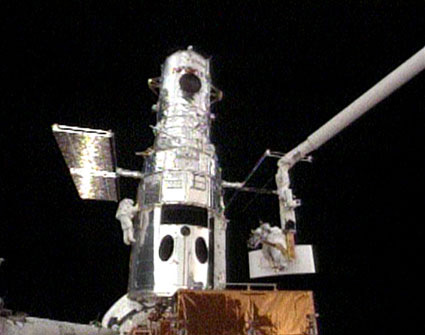Astronauts Give Hubble Telescope New Camera Eye

Thisstory was updated at 5:15 p.m. EDT.
HOUSTON -Atlantis astronauts gave the ailing Hubble Space Telescope a deeper view intothe universe Thursday in the form of a new camera eye during the first of fivegrueling spacewalks to fix the iconic observatory.
SpacewalkersJohn Grunsfeld and Andrew Feustel floated outside their shuttle to begin morethan seven hours of work to boost the 19-year-old Hubble?svision and fix a key computer unit that beams images to Earth. Not since2002 had astronauts touched the space telescope, which had some stuck boltsand other surprises waiting for its repairmen.
?We got toHubble and gave Hubble a hug,? said Grunsfeld, who led the spacewalk and ismaking his third trip to the telescope. ?And in traditional Hubble fashion,Hubble threw us a few curves.?
Thespacewalk began late and then stalled as astronauts tackled stubborn bolts onHubble?s old workhorse imager - the Wide Field Planetary Camera 2 - which theyreplaced with a vastly improved one. The old camera was installed in1993 and is responsible for some of Hubble's mostfamous images, but it refused to budge when the spacewalkers tried tounbolt it.
Afterputting in some extra elbow grease, Feustel freed the stuck camera to therelief of his crewmates and Mission Control.
?I think Igot it,? Feustel said. ?Woohoo! It?s moving out!?
Breaking space news, the latest updates on rocket launches, skywatching events and more!
The oldcamera will be returned to Earth aboard Atlantis and eventually displayed atthe Smithsonian Institute?s National Air and Space Museum, Hubble scientistssaid.
?It?s beenin there 16 years, Drew,? Grunsfeld said.
?It didn?twant to come out,? Feustel replied.
The seven astronautsaboard Atlantis are flying an 11-day mission that is NASA?s fifth and finalservice call on the Hubble Space Telescope. Tomorrow, a different pair ofspacewalkers will replace Hubble?s aging gyroscopes and a set of old batteriesin order to extend the space telescope?s lifetime through at least 2014. Inall, Atlantis astronauts will perform five spacewalks in as many days.
Hubble?snew camera eye
Grunsfeldand Feustel replaced Hubble?s old imager with the WideField Camera 3, a new $132 million instrument expected to probe deeper intothe evolution of galaxies and the shed new light on the mysteries of darkmatter and dark energy. It is designed to see back to about 500 million yearsafter the birth of the universe. The universe is 13.7 billion years old.
?This isour highest priority science instrument,? said Jon Morse, NASA?s astrophysicsdivision chief, in a Wednesday briefing here at the Johnson Space Center.
The newcamera weighs 900 pounds (408 kg) and is about the size of a baby grand piano. Grunsfeldsaid camera would ?help unlock the secrets of the universe.? Flight controllersin Hubble?s control center at NASA?s Goddard Space Flight Center in Greenbelt,Md., successfully powered up the new camera to the delight of Atlantis? crew.
?That?sawesome news,? said astronaut Michael Massimino, who choreographed thespacewalk from inside Atlantis. Astronaut Megan McArthur flew the shuttle?srobotic arm.
Spacewalkersalso replaced an ailing science data handling unit on Hubble that failed lastfall and delayed Atlantis? current mission by seven months. Engineers revived the telescope with a temporary fix until today's repair, which went swiftly.
Thespacewalkers also attached a docking mechanism on Hubble so a roboticspacecraft grab the telescope when its mission is over and send it plummetinginto the Pacific Ocean. They also lubricated some of Hubble?sdoors and tried to install door mechanisms that also gave them some trouble.
?It?s a dayof surprises,? Feustel said.
Spacewalkmarathon kicks off
Thursday?sspacewalk began at 8:52 a.m. EDT (1252 GMT) and sets the stage for anotherrepair job on Friday. The astronauts were dwarfed by the four-story Hubbleabove them in television images relayedfrom the shuttle.
Thespacewalk lasted 7 hours, 52 minutes and marked the sixth career excursion forGrunsfeld, who ended with 44 hours and 52 minutes. It was Feustel?s firstspacewalk.
?I?m readyfor a hot shower and good meal,? one of the spacewalkers said near the end.
?We?ll seewhat we can do,? Massimino said.
Atlantis launchedMonday and is flying in an environment littered with space junk because ofHubble?s high orbit. Debris from a 2007 Chinese anti-satellite test zipped by theshuttle late Wednesday, but notclose enough to require the shuttle move out of the way, NASA officialssaid. NASA has the shuttle Endeavour on standby as a rescue craft if needed.
NASAinitially canceled the $1.1 billion Hubble flight in 2004 citing it as toorisky in the wake of the Columbia shuttle disaster. But the agency reversedthat decision in 2006 after successfully resuming shuttle flights and testingshuttle inspection and repair techniques.
SPACE.comis providing continuous coverage of NASA's last mission to the Hubble SpaceTelescope with senior editor Tariq Malik in Houston and reporter ClaraMoskowitz in New York. Clickhere for mission updates, live spacewalk coverage and SPACE.com'slive NASA TV video feed.
- New Videos - Hubble's High Art, New Camera
- New Video Show - Hubble's Final Shuttle Service Call
- Image Gallery - The Hubble Repair Missions: Part 1, Part 2

Tariq is the award-winning Editor-in-Chief of Space.com and joined the team in 2001. He covers human spaceflight, as well as skywatching and entertainment. He became Space.com's Editor-in-Chief in 2019. Before joining Space.com, Tariq was a staff reporter for The Los Angeles Times covering education and city beats in La Habra, Fullerton and Huntington Beach. He's a recipient of the 2022 Harry Kolcum Award for excellence in space reporting and the 2025 Space Pioneer Award from the National Space Society. He is an Eagle Scout and Space Camp alum with journalism degrees from the USC and NYU. You can find Tariq at Space.com and as the co-host to the This Week In Space podcast on the TWiT network. To see his latest project, you can follow Tariq on Twitter @tariqjmalik.
